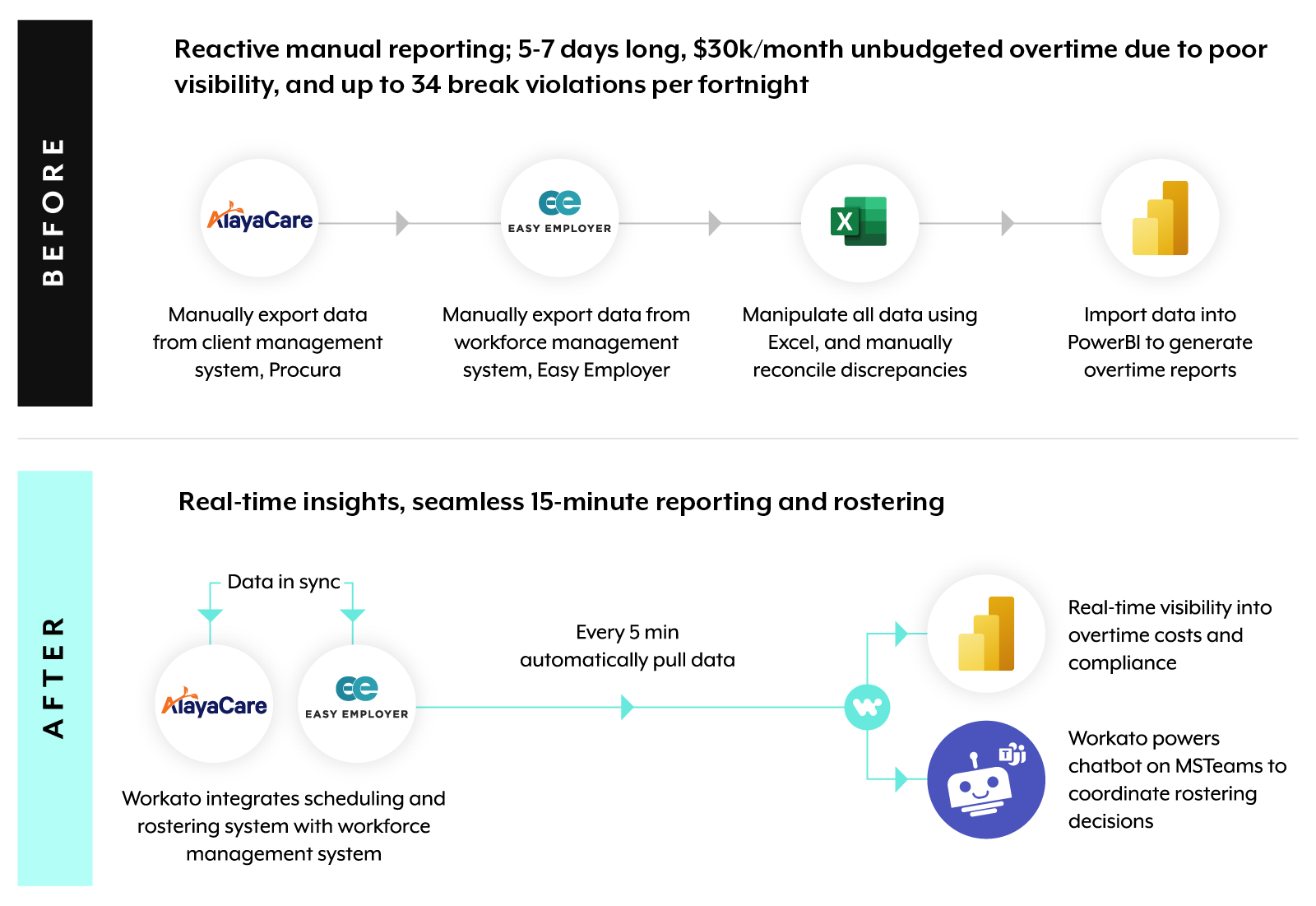Established by concerned parents and carers in Dandenong Australia, ERMHA365 has grown to provide complex mental health and disability services across Victoria Australia and the Northern Territory, empowering individuals and communities facing life’s toughest challenges to overcome adversity and thrive. Yet, scaling their own operations was an uphill battle.
Even with over 600 staff committed to delivering innovative, flexible, and client-focused care, disconnected systems and manual administration got in the way. Peppe Prestia, ERMHA365’s Systems Application Manager , understood these challenges all too well. As a self-described “non-IT IT person” who journeyed from direct support work to IT systems administration, he set out to free up time for his committed colleagues to focus on their primary objective: helping individuals and communities overcome adversity and flourish.
Reactive reporting, breaches and burnout
Prior to engaging UST Leonardo, ERMHA365 grappled with critical operational challenges:
- Disconnected manual processes: Rostering, overtime tracking and compliance reporting processes required repetitive manual exports and tedious data manipulation. Reports took 5 to 7 days to generate, because siloed data was buried within disconnected systems.
- Poor visibility: With data often going out-of-date by the time it reached decision-makers, short-term decisions were made without insight into how it affects payroll.
- Budget overruns: Inefficient manual processing caused unbudgeted overtime costs to spiral to AU$ 30,000 every month – funding that could have instead been allocated to client services. Yet the only way of monitoring these costs was lagging and not leading.
- Compliance considerations: Legacy rostering processes presented opportunities for improvement, to align with FairWork pay award requirements. ERMHA365 identified enhanced visibility and automation as key to reducing scheduling anomalies, such as Less than Required Break (LRB) intervals, and ensuring consistent compliance.
With overtime costs escalating and no means to provide a forward-looking view of roster-based staffing expenses, Peppe drew up a strategic plan to modernise service delivery for clients with complex care needs. The goal was to shift from reactive to proactive workforce management. This strategy prioritised flexibility, innovation and agility.
ERMHA365 partnered UST Leonardo to conduct a technical assessment involving process owners from 4 teams – IT and Systems, rostering and scheduling, people and culture, as well as executive leadership.
Intelligent monitoring and data syncs
All roads pointed towards the need for an iPaaS platform. One that powerfully synchronises data between disparate systems, while empowering ERMHA365’s lean IT team to independently build, maintain and scale workflows to swiftly meet evolving needs.
Prioritising flexibility, innovation and agility, UST Leonardo recommended Workato, which stood out to ERMHA365 for several reasons:
- a single build experience, unifying automation, integration on an intuitive recipe interface,
- proven success in similar health and aged care settings,
- a rich array of robust pre-built connectors (e.g. to Microsoft 365 and PowerBI),
- real-time integration and scheduling capabilities, and
- the ability to trigger alerts in response to specific workforce events, driving action directly via an interactive chatbot (on MSTeams).
ERMHA365 soon began orchestrating with Workato to reimagine mission-critical processes for workforce management and optimisation, compliance, and data accuracy.
Here’s a preview into an intelligent overtime monitoring solution UST Leonardo built for ERMHA365, using Workato:

Meanwhile, another solution ensures proactive compliance monitoring, making violations impossible:

Extensive training and enablement by UST Leonardo ensured that ERMHA365’s internal teams could sustainably manage and extend these integrations too. By aligning outcomes with values, Leonardo helped shift the conversation and demonstrated immediate value.
Immediate impact: speed, savings & compliance
The exceptional results marked a paradigm shift for ERMHA365:
- 84% less monthly overtime cost: Overtime spend dropped by 84% within the first quarter reporting cycle that followed the rollout of the reimagined workflow.
- 40% Rostering Improvement: Rostering has also dramatically improved, with a 40% reduction in time spent creating a roster, and staff filling shifts at least 50% more quickly.
- $300K+ recovered annually: These savings are now being redirected towards core community health programs.
- 160 times faster reporting: Time spent generating reports went down from 5 days to 15 minutes, drastically improving data accuracy and responsiveness by saving staff 40 hours of manual administration every fortnight.
- Zero violations: From a peak of 34 violations per fortnight, ERMHA365 reimagined the process to make violations impossible, eliminating the risk of compliance penalties and improved patient care.
- Confident, empowered staff: The solutions received high praise from employees, particularly rostering teams who now have greater confidence in scheduling decisions and more time to focus on care delivery rather than administration.
- Swift deployment: Compared to more monolithic integration platforms, traditional middleware or custom scripts, Workato offers a faster path to deployment and is a better fit for ERMHA365’s lean IT environment. 10 weeks was all it took to go live with several end-to-end integrations. A scalable integration framework and reusable recipes promise to accelerate this further.
The future of client-centric care
Beyond the efficiency gains, Leonardo’s solution established a scalable integration framework for ERMHA365, aligned with their strategic focus on innovation, flexibility and agility in service delivery. Armed with an Workato integration & orchestration platform, ERMHA365 is able to:
- proactively empower managers with real-time analytics to make informed decisions swiftly,
- shift organisational culture from reactive problem-solving to proactive strategic management, and
- have confidence in their technology stack that will adapt to the ever-changing environment of mental health and disability.

